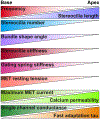Mechanotransduction in mammalian sensory hair cells
- PMID: 35218890
- PMCID: PMC9177625
- DOI: 10.1016/j.mcn.2022.103706
Mechanotransduction in mammalian sensory hair cells
Abstract
In the inner ear, the auditory and vestibular systems detect and translate sensory information regarding sound and balance. The sensory cells that transform mechanical input into an electrical signal in these systems are called hair cells. A specialized organelle on the apical surface of hair cells called the hair bundle detects mechanical signals. Displacement of the hair bundle causes mechanotransduction channels to open. The morphology and organization of the hair bundle, as well as the properties and characteristics of the mechanotransduction process, differ between the different hair cell types in the auditory and vestibular systems. These differences likely contribute to maximizing the transduction of specific signals in each system. This review will discuss the molecules essential for mechanotransduction and the properties of the mechanotransduction process, focusing our attention on recent data and differences between the auditory and vestibular systems.
Keywords: Adaptation; Auditory; Cochlea; Frequency selectivity; Hair bundle; Hair cell; MET; MT; Mechanotransduction; Otolith; Stereocilia; Vestibular.
Copyright © 2022 The Authors. Published by Elsevier Inc. All rights reserved.
Conflict of interest statement
Declaration of interests
The authors declare that they have no known competing financial interests or personal relationships that could have appeared to influence the work reported in this paper.
Figures



References
-
- Ahmed ZM, Goodyear R, Riazuddin S, Lagziel A, Legan PK, Behra M, Burgess SM, Lilley KS, Wilcox ER, Griffith AJ, Frolenkov GI, Belyantseva IA, Richardson GP, Friedman TB, 2006. The tip-link antigen, a protein associated with the transduction complex of sensory hair cells, is protocadherin-15. J Neurosci 26, 7022–7034. - PMC - PubMed
-
- Alagramam KN, Murcia CL, Kwon HY, Pawlowski KS, Wright CG, Woychik RP, 2001. The mouse Ames waltzer hearing-loss mutant is caused by mutation of Pcdh15, a novel protocadherin gene. Nat Genet 27, 99–102. - PubMed
Publication types
MeSH terms
Grants and funding
LinkOut - more resources
Full Text Sources
Miscellaneous

